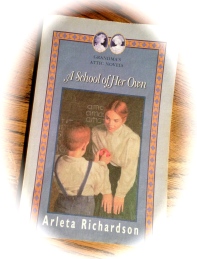I gazed around the room one more time. The teacher’s bell, the hooks for hanging lunch pails, the well-used desks and the well-loved McGuffeys. Even though I was heading toward new adventures, it was hard to say goodbye.
We had shared quite a bit of history, this room and I. Once I was a little girl who sat at a little desk and used a slate pencil. Back then, I thought it would be pretty awesome to be a teacher with a school just like this. Why not? I had read about it in books like the Little House series or the Boxcar Children’s Schoolhouse Mystery. But there was a problem: I was in a century that wasn’t very one-room school friendly.
Then, in a snap and a whirl, I grew up and found myself behind the teacher’s desk of that place of childhood dreams. And a roomful of students gazed back at me!
Yes, I had become the one-room school teacher at the living history museum. Children came by the busload to learn about life in bygone days. You can imagine the fun of ringing the bell as various-sized students propelled themselves in my direction.
However, there would be no running into my school “like a herd of pigs headed for the trough.”[1] At my instruction, the students lined up with girls on one side and boys on the other. Then they walked in, took their seats,
and we began our lessons. 
Looking back, I felt quite a bit like Mabel O’Dell welcoming students in A School of Her Own. At eighteen, Mabel finds herself teaching in a one-room school in Michigan, dodging a vicious goat, grading papers, getting lost in a blizzard, dealing with the challenges that come with a classroom and a small town, and learning about the Lord. Inspired by the life of and stories from the author’s grandmother, this book brings history and heart together.
What is the point of bringing history and heart together? It’s about making history alive with real people who faced real problems and had real stories. It takes the facts (which are important) and goes beyond them to the relationships. I think that sums up what I hoped to share with my students in my one-room school. With the groups, I had only fifteen minutes (or less) to do it. Talk about a challenge! My history manual and older folks who had attended one-room schools or taught in them were my best resources for true stories to put a sparkle on the facts. Sometimes I think I may have shared more of the fun stories – like the skiing to school and the recess games – and given a somewhat sunshiny picture of life back then. However, I know I tried to communicate facts like how school children really had to work hard to help their families. A School of Her Own balances the fun with the realities that people were still sinners and life definitely had its hard moments in the 19th century just like in the 21st.
So there I stood in my school, admiring all the familiar details. To think I had come so very close to being a real one-room school teacher! While I hadn’t faced life-changing decisions with surprising answers quite like Mabel, I had learned, as I suppose many teachers do, as much as I had taught in that room. It was now part of my history, and it was definitely part of my heart. I hope sharing the story brings it to others’ hearts as well, maybe even yours.
If you’d like to read all about Mabel O’Dell’s escapades and learn about life for a one-room school teacher, check out A School of Her Own by Arleta Richardson. Perhaps you’ll even decide to visit a one-room school! Whether you read or visit, I’d love to hear your thoughts on bringing history and heart together. Note: As I mentioned, the book does touch on some of the more complicated issues of life. Parents may want to check it over before handing it to young readers.
Special thanks to my childhood friends Katie and Ann S. who, I think, introduced me to Arleta Richardson’s books. I guess you never know what a book recommendation might bring about!
1 Arleta Richardson, A School of Her Own, Grandma’s Attic Novels (Colorado Springs: Cook Communications Ministries, 1986), 49.


